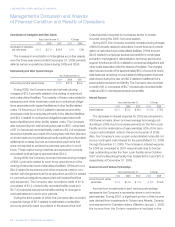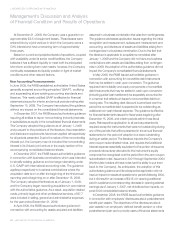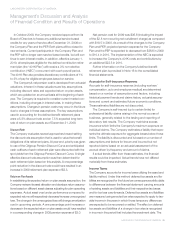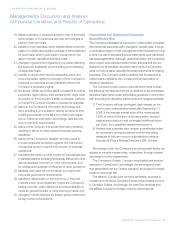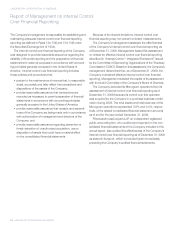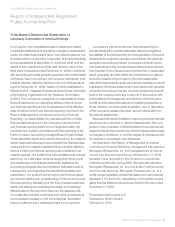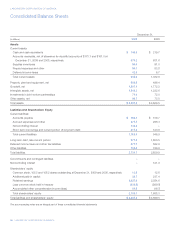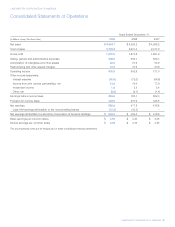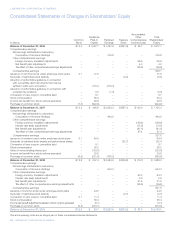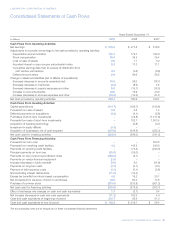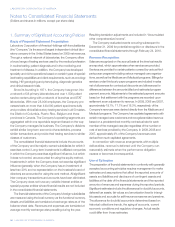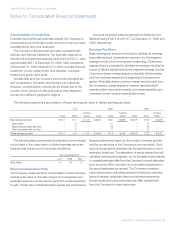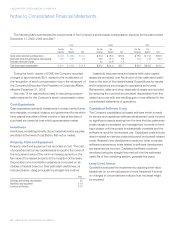LabCorp 2009 Annual Report Download - page 35
Download and view the complete annual report
Please find page 35 of the 2009 LabCorp annual report below. You can navigate through the pages in the report by either clicking on the pages listed below, or by using the keyword search tool below to find specific information within the annual report.LABORATORY CORPORATION OF AMERICA 33
LABORATORY CORPORATION OF AMERICA
Management’s Discussion and Analysis
of Financial Condition and Results of Operations
19. failure to develop or acquire licenses for new or improved
technologies, or if customers use new technologies to
perform their own tests;
20. inability to commercialize newly licensed tests or technol-
ogies or to obtain appropriate coverage or reimbursement
for such tests, which could result in impairment in the
value of certain capitalized licensing costs;
21. changes in government regulations or policies affecting
the approval, availability, and the selling and marketing
of diagnostic tests;
22. inability to obtain and maintain adequate patent and
other proprietary rights for protection of the Company’s
products and services and successfully enforce the
Company’s proprietary rights;
23. the scope, validity and enforceability of patents and other
proprietary rights held by third parties which might have
an impact on the Company’s ability to develop, perform,
or market the Company’s tests or operate its business;
24. failure in the Company’s information technology sys-
tems resulting in an increase in testing turnaround time
or billing processes or the failure to meet future regula-
tory or customer information technology, data security
and connectivity requirements;
25. failure of the Company’s financial information systems
resulting in failure to meet required financial reporting
deadlines;
26. failure of the Company’s disaster recovery plans to
provide adequate protection against the interruption
of business and/or to permit the recovery of business
operations;
27. business interruption or other impact on the business due
to adverse weather (including hurricanes), fires and/or other
natural disasters, terrorism or other criminal acts, and
for widespread outbreak of influenza or other pandemic;
28. liabilities that result from the inability to comply with
corporate governance requirements;
29. significant deterioration in the economy or financial
markets which could negatively impact the Company’s
testing volumes, cash collections and the availability of
credit for general liquidity or other financing needs; and
30. changes in reimbursement by foreign governments and
foreign currency fluctuations.
Quantitative and Qualitative Disclosure
About Market Risk
The Company addresses its exposure to market risks, principally
the market risk associated with changes in interest rates, through
a controlled program of risk management that includes from time
to time, the use of derivative financial instruments such as interest
rate swap agreements. Although, as set forth below, the Company’s
zero-coupon subordinated notes contain features that are con-
sidered to be embedded derivative instruments, the Company
does not hold or issue derivative financial instruments for trading
purposes. The Company does not believe that its exposure to
market risk is material to the Company’s financial position or
results of operations.
The Company’s zero-coupon subordinated notes contain
the following two features that are considered to be embedded
derivative instruments under authoritative guidance in connection
with accouting for derivative instruments and hedging activities:
1) The Company will pay contingent cash interest on the
zero-coupon subordinated notes after September 11,
2006, if the average market price of the notes equals
120% or more of the sum of the issue price, accrued
original issue discount and contingent additional princi-
pal, if any, for a specified measurement period.
2) Holders may surrender zero-coupon subordinated notes
for conversion during any period in which the rating
assigned to the zero-coupon subordinated notes by
Standard & Poor’s Ratings Services is BB- or lower.
Borrowings under the Company’s revolving credit facility are
subject to variable interest rates, unless fixed through interest
rate swaps or other agreements.
The Company’s Ontario, Canada consolidated joint venture
operates in Canada and, accordingly, the earnings and cash
flow generated from the Ontario operation are subject to foreign
currency exchange risk.
The Alberta, Canada joint venture partnership operates in
Canada and remits the Company’s share of partnership income
in Canadian Dollars. Accordingly, the cash flow received from
this affiliate is subject to foreign currency exchange risk.



